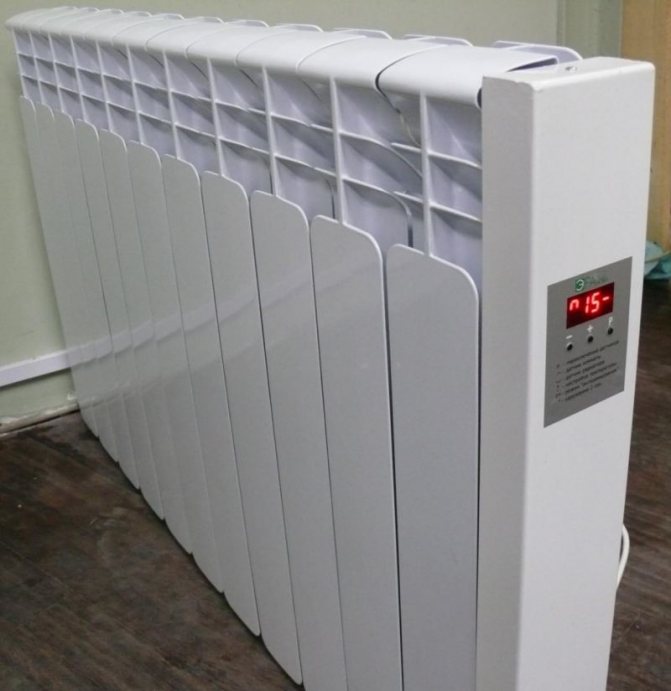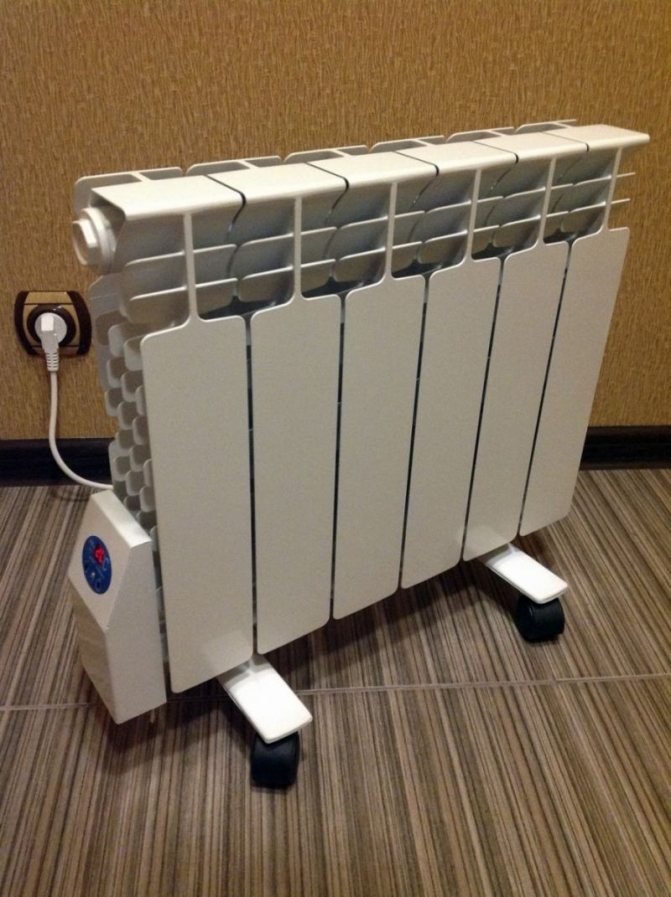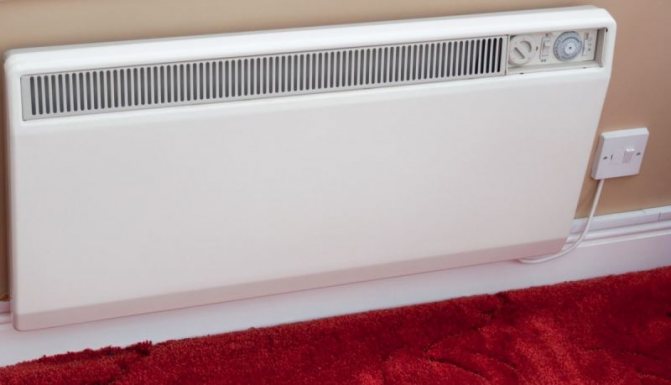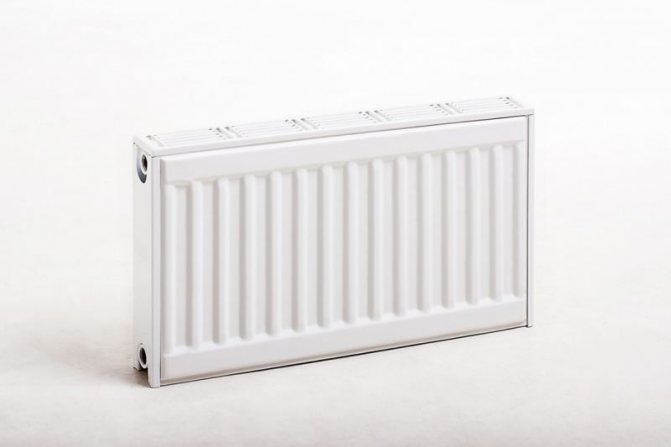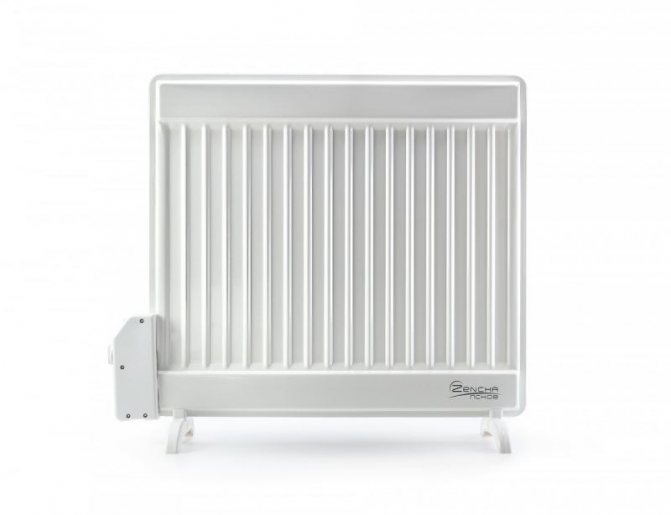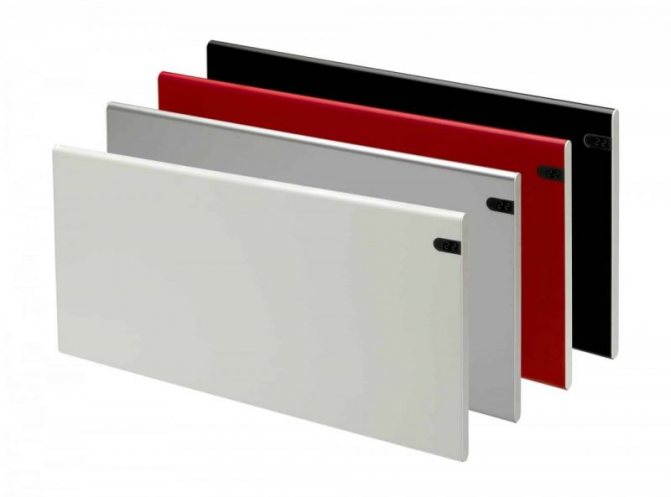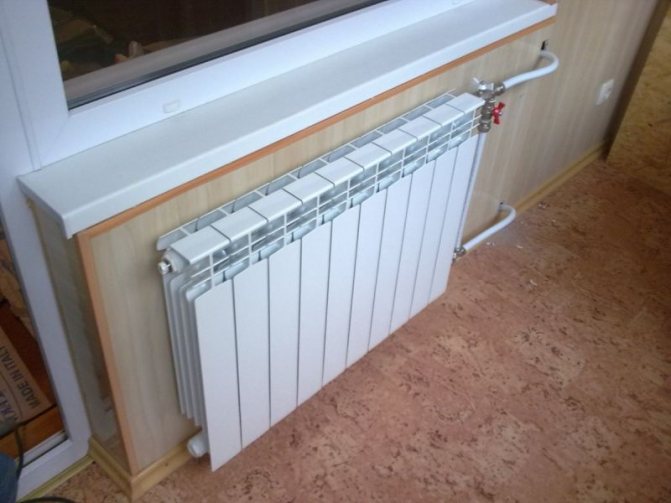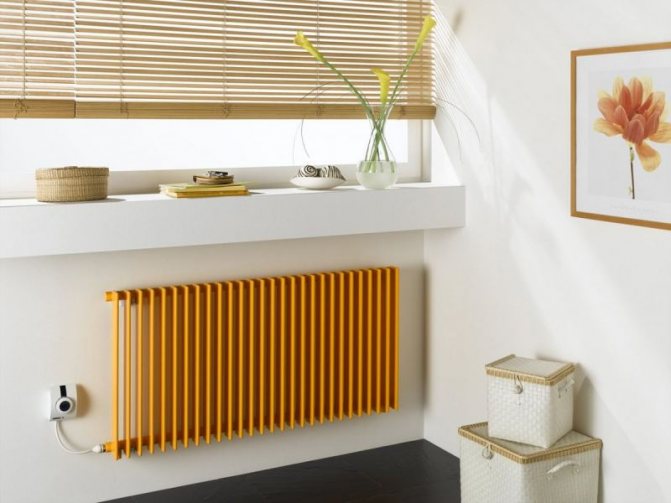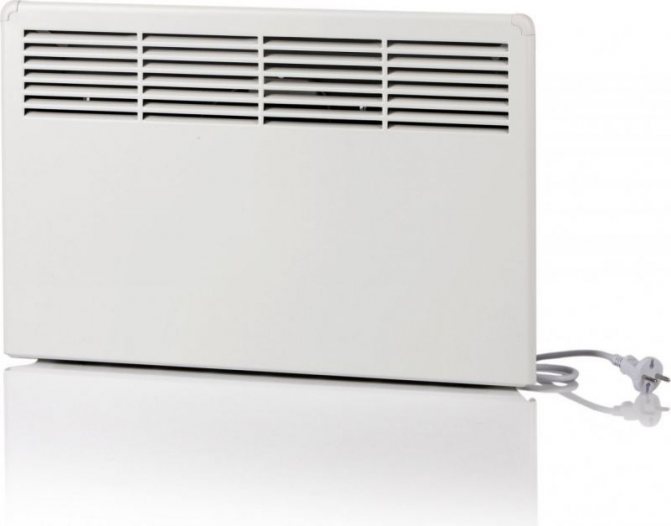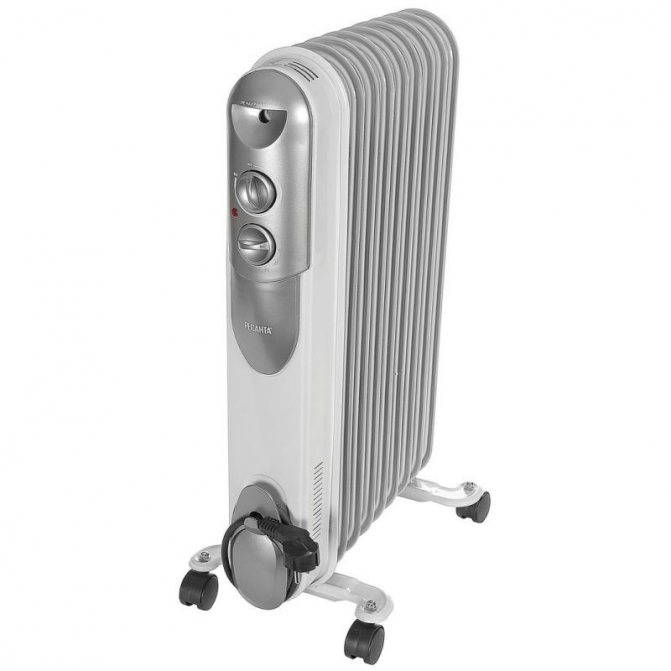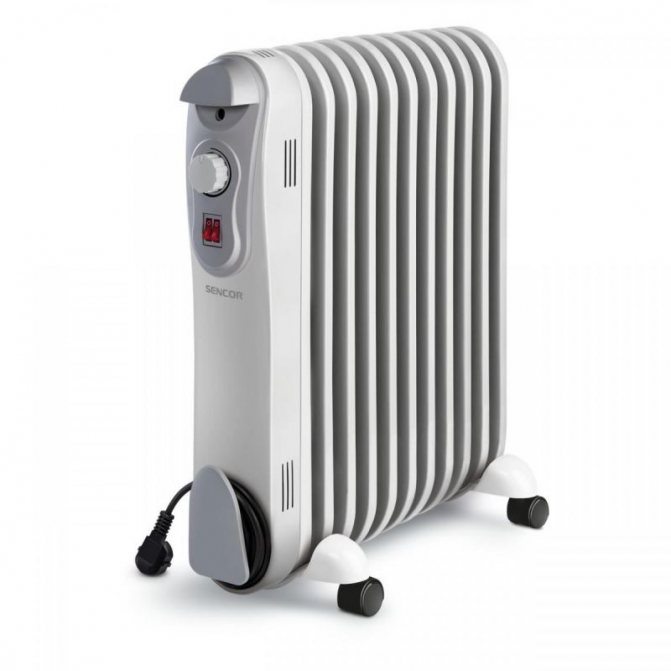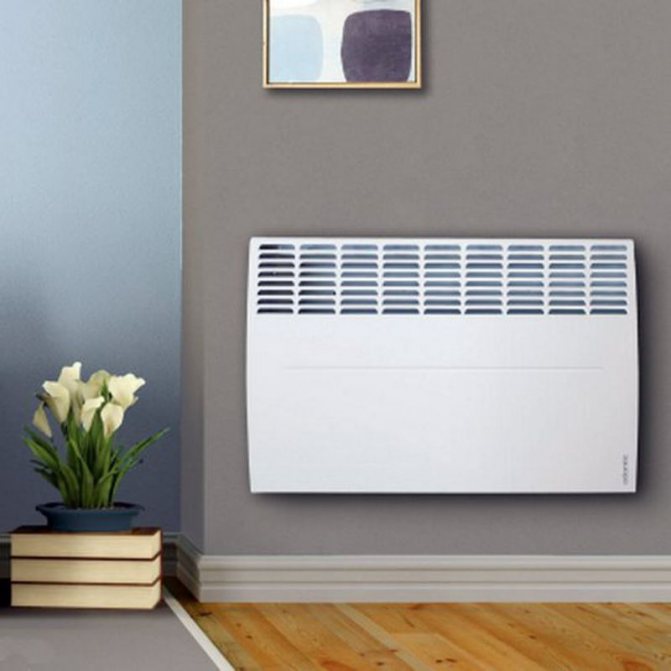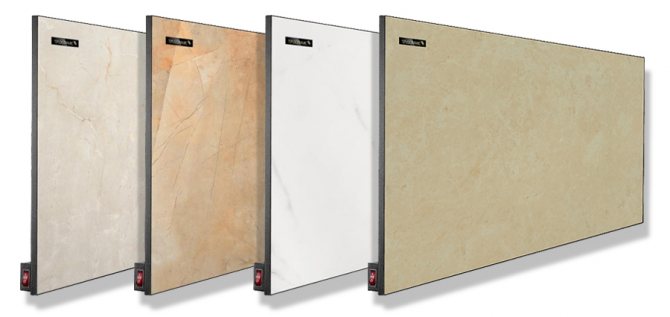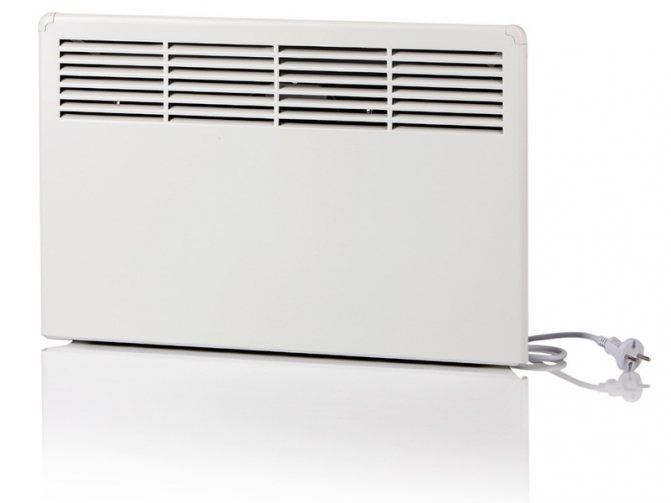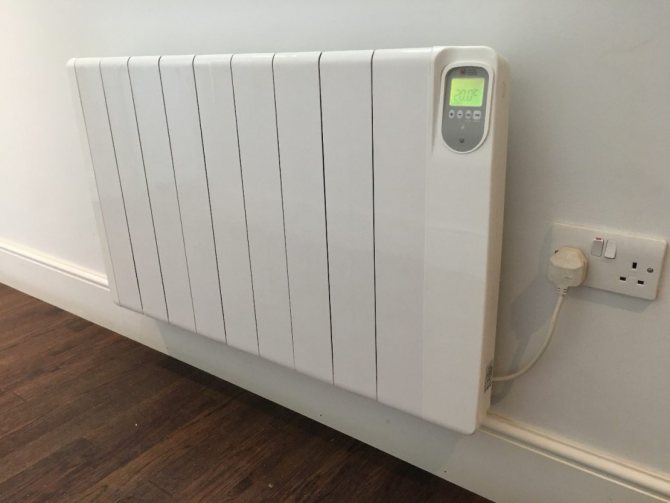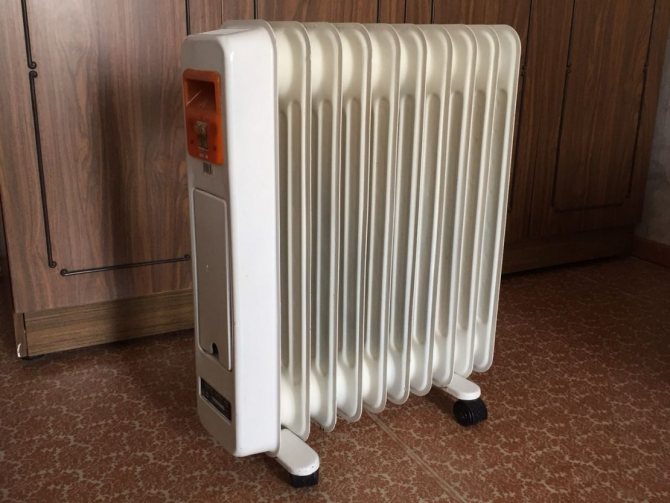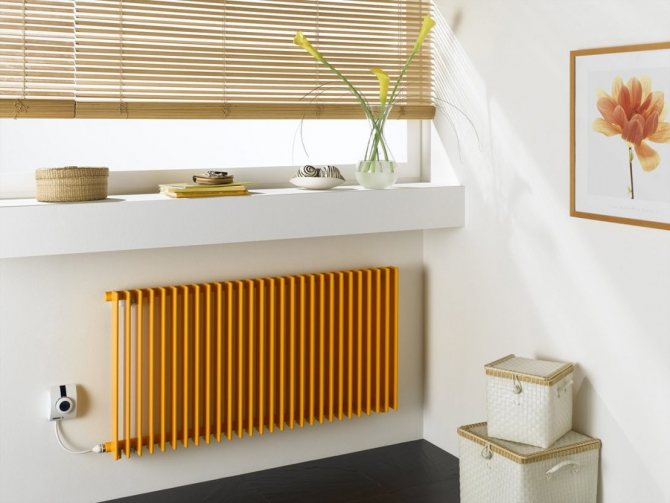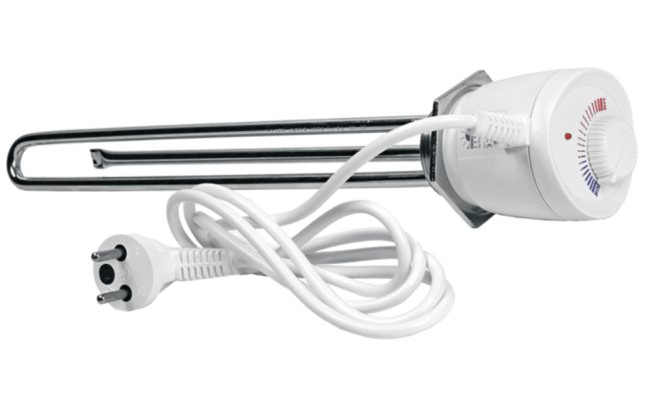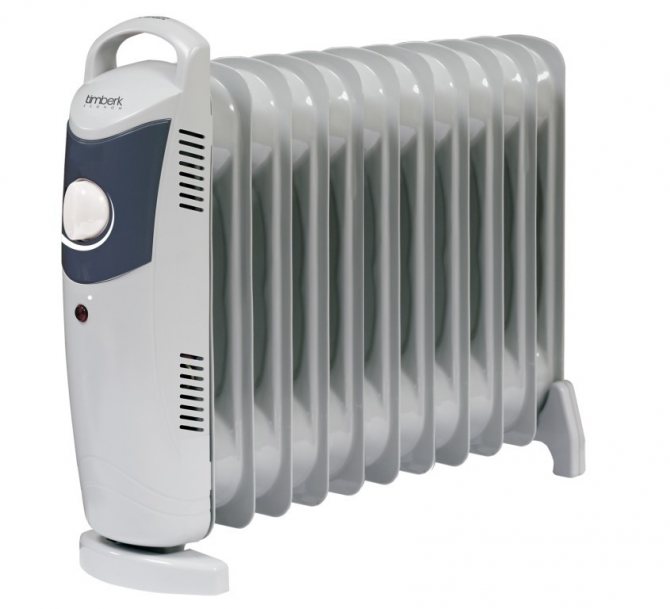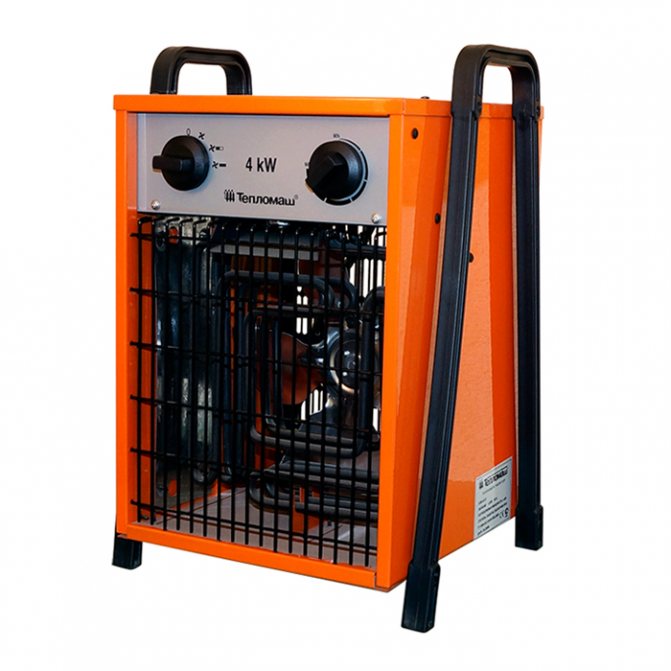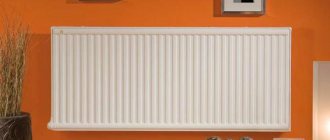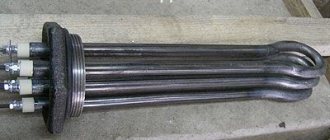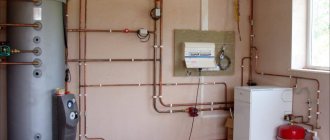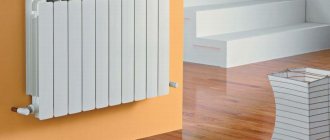Wall mounted electric heaters of oil type
Oil-type wall-mounted electric heaters have a sealed body made of steel, which contains mineral oil and a tube-type electric heater. They work according to an extremely simple principle: hot oil heats up the metal, and the heat energy emitted by it gradually heats the air and the wall. Heat is reflected from the wall and spreads throughout the room.

Almost everyone knows about these devices. They are characterized by a long service life, affordable cost and noiselessness. The body of this device does not get hot, therefore, it dries up the air in the same way as simple water batteries, but no more.
Of course, they also have disadvantages, including an impressive weight, which makes installation difficult for some types of partitions, as well as the fact that the room heats up rather slowly. It is undesirable to install oil-type devices in bathrooms, as well as leave them in country houses without use.
How vacuum electric batteries work
Vacuum radiators are a more economical option in comparison with oil-filled electric batteries. Their work is based on the heating of a special liquid. located in the lower part of the aluminum case, easily evaporating and quickly spreading heat over the surface of the device. A feature of the liquid filling a vacuum electric battery is a low boiling point - only 35 degrees C and a small volume - 500 ml.
The heat transfer of a vacuum electric battery is quite large - about 300 W for each section. When the battery is disconnected, it retains heat for a long time. gas particles in a vacuum continue to move, albeit somewhat slower.
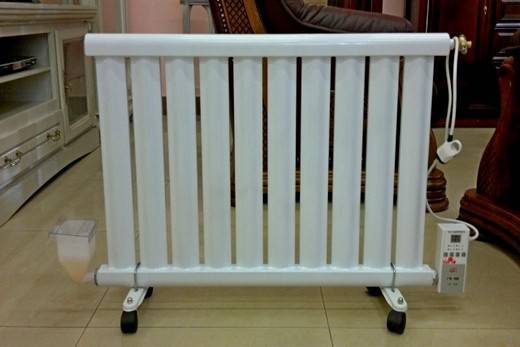

An electric vacuum radiator is a good option for economical heating
The set of heaters includes emergency shutdown sensors and temperature controllers. The positive aspects in the operation of vacuum radiators include:
- Ease of installation;
- No need for auxiliary equipment;
- Nice design;
- Autonomy;
- The ability to regulate the temperature in a wide range - 20-70 degrees C.
Attention! As a disadvantage, it should be noted that the vacuum battery cannot be tilted. It should stand on a perfectly flat surface.
Advantages and disadvantages
Oil-fired electric heating radiators have a number of positive qualities, including:
- Compactness. These batteries take up little space.
- Mobility. Most models, thanks to the castors, can be easily moved from room to room.
- Security. The metal case does not heat up above + 60 ... + 70 ° C, which excludes the possibility of burns and injuries. All working elements heated to high temperatures are located inside the casing.
- Silence. Oil batteries do not make noise during operation (except for models equipped with fans).
- They do not dry out the air in the room, do not burn out oxygen and do not emit unpleasant odors (in comparison with devices with open heating elements).
- Affordable price.
- Ease of operation. You just need to plug the cord into an outlet and follow some simple rules.


The disadvantages of such designs include the following qualities:
- Inertia. Mineral oil reaches its operating temperature for a long time (due to its high heat capacity) and the room heats up slowly.But the liquid does not cool down immediately, gradually giving off the accumulated heat.
- Quite large weight and dimensions, which is not always convenient. The disadvantage is compensated by the presence of wheels.
Convection type devices
Convectors are electric heaters, which can be both wall-mounted and floor-mounted. Their principle of operation is based on the constant heating of cold air, which goes down in accordance with the laws of physics. These devices evenly warm up the room, but at the same time they do not burn oxygen as much as the older versions - heat fans.


How does a wall mounted electric heater work?
Convection electric wall heaters include the body itself and the heating element itself. In the first, special holes have been made - cold masses enter the grilles located in the lower part, quickly warm up and leave the device through the upper blinds located on the front part.


Recently, manufacturers are increasingly abandoning needles, giving preference to heating elements - such devices are more durable, they do not heat up so much, in addition, they can be used even in rooms where the level of humidity is high. Monolithic elements are elements of the case and are considered the most effective (moreover, they are the quietest and most durable).
Note! Depending on the principle of operation, convectors can be of two types - active and passive. The former are equipped with a special forced fan, which increases the speed and efficiency of work.
Almost all modern convectors have a waterproof case, which is why they can be installed even in showers and bathrooms. Finally, the heating of the case often does not exceed 50-60 C, therefore, accidental burns are completely excluded.
The former are equipped with a special forced fan, which increases the speed and efficiency of work. Almost all modern convectors have a waterproof case, which is why they can be installed even in showers and bathrooms. Finally, the heating of the case often does not exceed 50-60 C, therefore, accidental burns are completely excluded.
Panel radiators
How to carry out the installation correctly, as well as the average prices for panel radiators in our detailed review, see here
Technical characteristics of convection appliances
When choosing a wall heater, you need to take into account the fact that their efficiency and performance depend on the power, and not on the dimensions of the case. And if the ceiling height is standard, then for every 10 m2 of area, 1 kW of equipment power is required
This is the most important indicator, but not the only one - attention should be paid to a number of others.
- Air humidification. A humidifier built into the appliance neutralizes the dryness of the air caused by the operation of an electric heater.
- Thermostat. It is necessary in order to regulate the heating temperature. More modern models are equipped with electric thermostats, which allow you to more accurately adjust the operation of the equipment.
- Ionizer. Another "trick" in which oxygen receives a negative charge, being under high voltage. This module is especially important for those consumers who really care about their own health.
- Timer. Another useful module that allows you to adjust the operating time of the equipment with the utmost simplicity.
- Remote control. A very convenient addition, with which you can instantly make adjustments to the settings without leaving the cozy sofa.
- Anti-freezing. This is a mode that automatically turns on the heater in the event of a critical drop in temperature. It is also very useful, especially in the country or in a private house, where they live inconstantly.
- Restart.The device automatically turns on with the preset settings. It is triggered when there is a power outage.
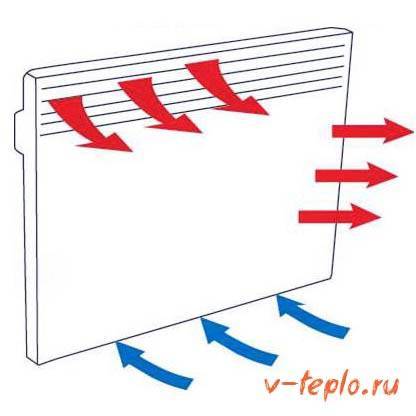

Popular electric heating batteries and their functionality
Throughout his development, man has sought to improve the heating of the home. Primitive bonfires were replaced by stoves and fireplaces, which heated the house locally or centrally, and later the heat was supplied through specially designed systems.
Today, private houses are heated using water or steam heating batteries, which are heated by gas. But this type of heating is acceptable for areas where it is possible to connect to a central highway. What should consumers do if they are unable to connect to gas? Electric radiators for space heating are a worthy replacement for water radiators heated with gas or solid fuel.
Is it profitable to heat the house with electricity?
Electric heating batteries are a real salvation for residents of private houses, for whom gas connection is a problem. There is a stereotype about the high cost of heating houses with electricity, but this is a misconception. There are several conditions, by fulfilling which, you can significantly save on electricity bills.
Firstly, the house must be connected to a 3-phase 380 V power line. Permission for such a connection is given by the RES engineer, subject to the availability of available capacities. What gives 380 V? Electric radiators will work in full force, and the meter will not knock out due to the increased volume of consumption, which it is unable to cope with due to its technical characteristics.
Second, a new three-phase meter is a great way to start saving. As you know, the cheapest electricity is generated at night. The energy received by the consumer is paid at different rates depending on the time of day: for example, daytime traffic is more expensive, and nighttime traffic is cheaper. Thus, heating a house with electric radiators up to 100 square meters will cost mere pennies. For this reason, experts often call electric batteries for heating a private house, prices for which are low, energy-saving and affordable.
What is an electric battery?
An electric battery or radiator is several elements (two or more) connected to each other. The sections are capable of converting the incoming energy into electrical energy, and the more elements are connected into a single structure, the better the device heats up. In appearance, electric radiators often look like water batteries. But the difference between them lies in the "filling": instead of water, a current is used in the structure, which acts on the heating element "TEN", thereby forcing it to generate heat.
Electric heating radiators are similar to oil appliances, but only in one characteristic: liquid oil serves as a heat carrier in both types. Mineral oil is hermetically sealed in the device, so there is no need to fear leakage.
Radiators powered by electrical energy are protected from overheating by a special system.
Another advantage of electric radiators is their compactness and variety in shape and color solutions, thanks to which they will fit into any interior.
It is worth noting heaters with stones: after heating, natural material is able to retain heat for several days. You can regulate the heat supply by radiators using built-in thermostats. And devices without thermostats will allow you to mount a single heating system controlled by one common regulator. As the latter, an electric heating boiler is often used - an aesthetic and compact device that looks great on the wall.
Where are electric batteries applicable?
Electric batteries for economical heating, as mentioned above, are indispensable in the private sector, where there is no possibility of connecting to the central gas main. In a private house, electric convectors are also very popular, which you can read about here. Often, electric heating is installed in new buildings as the main or additional source of heat. So, the batteries in the apartment will come in handy in the off-season, when the central heating is not yet functioning, and the weather outside the window does not please with warmth. And, undoubtedly, not a single owner of a cottage, apartment or summer cottage will refuse to buy an electric heating battery as an alternative source of heat if the existing system malfunctions with a regular frequency.
Benefits of installing an electrical system
There are enough arguments for installing electric radiators as the main or backup heat source. These are the aesthetics of devices, environmental friendliness, safety and a number of other advantages, including the low cost of energy consumption.
Microclimate to taste
An electric heating battery is the simplest device to operate. It allows consumers to adjust the climate in their home to their liking. There are models equipped with an electronic thermostat, through which the set temperature is maintained. At the same time, the generated heat does not burn oxygen, which happens when other heat sources are used. In addition, the indoor air is not contaminated with gases, smoke and soot.
Calculation of the power of radiators
Today, energy-saving electric heating batteries are sold with any required number of elements (sections) with any power. Experts advise to select devices in accordance with the square of the room.
Low cost of electrical heating installation
In most cases, compact convection electric heating radiators are hung on the walls under the windows to create a thermal curtain. But a number of other models are also produced, which are mounted on the ceiling or disguised as skirting boards. The lightweight construction is attached with just 2 brackets, which is enough for efficient operation of devices for decades. Installation of electric radiators does not require time-consuming and expensive work associated with laying a chimney and gutting ditches for pipes. It is enough to buy an electric heating battery, attach it to the right place in the room and plug it into an outlet.
With careful handling, electric radiators serve for decades. Their simple design does not require expensive repairs. The maximum that is required is to replace the electric heaters for heating batteries, and they will not cost as much as purchasing a new radiator.
How to calculate the required power of the radiator?
When choosing battery models, you should pay attention to their characteristics. The most important of these are operating pressure and heat dissipation.
Working pressure is an indicator of the pressure of the coolant that the device is able to withstand without rupture. If we talk about aluminum radiators common today. then the manufacturers indicate the pressure in the range from 6 to 16 atm. The lower this indicator, the more suitable the device is for use in the private sector - in houses where the heat supply depends on the consumer himself and there are no pressure surges. And vice versa: it is recommended to buy an electric heating radiator with a high pressure indicator for an apartment. Then a rugged device will not be afraid of pressure drops in a centralized system.
Heat transfer power is an indicator that one section can give.
With a standard depth of an aluminum radiator of 110-140 mm, a height of up to 1000 mm and a thickness of up to 3 mm, the heating area is 0.4-0.6 square meters. The high heat transfer rate of an aluminum device increases by 80% if transverse ribs are provided in the battery design.
Domestic produces interesting devices. The inside of the radiators is made of steel and the outside is made of aluminum. The aluminum walls heat up instantly, and the internal steel elements retain heat perfectly. It is worth buying Rifar heating batteries because of their high heat transfer rates, excellent build quality and a 25-year warranty offered by the manufacturer. Rifar - heating radiators, the price of which is quite high in comparison with the price policy of competitors. So, a model from the "Monolith-500" series, consisting of 10 sections, will cost $ 100-120. and "Monolith-350" - at 70-90. But "Rifar" undoubtedly deserves attention.
How much do electric radiators cost?
The range of electric radiators on the market is amazing. Electric heating radiators can be bought both cheap and short-lived Chinese-made and elite European ones. Russian manufacturers produce models, the advantage of which is quality and price Electric heating batteries "Thermia" with a capacity of 1000 W are capable of heating a room up to 12 square meters. The model "Evna-1.0" will cost about 2400 rubles. Many users are interested in the network, what is an electric heating battery with the consumption of electricity from a light bulb. This is a Russian invention. The manufacturer claims that the new product consumes only 100 watts with the highest heat transfer rates. But experts say that EffectEnergo's bold statement is just a myth invented by marketers. And the cost of EffectEnergo products is much higher than conventional convectors, so before buying it is worth thinking about its expediency.
Electric heating radiators, reviews of which are mostly positive, perfectly heat premises for any purpose - from office to residential. The devices allow you to reduce heating costs and create a pleasant microclimate in the house without smoke, gases and drafts.
How to choose the perfect convector. Specialist recommendations


Needle heater radiator
Tip 2
When buying, pay attention to the heating element. The service life of the heating element is approximately 15 years.
This is already a lot for suburban buildings, but there are models with an even longer period. This is achieved with the help of better materials from which the body is made. Such heaters will be more expensive than conventional ones. However, it makes sense to buy them only for an apartment or private house. Tip 3. Electric convectors consist of several panels, each of which works autonomously. As a result, the structure heats up gradually. To correctly calculate the radiator power, you need to rely on the established standards for space heating: 100 W. power per 1 square meter of area. For example, for a room with an area of 20 sq. meters, you will need a unit with a power of 2000 watts. If the ceilings are high (from 3 m.), The capacity increases by 150%.
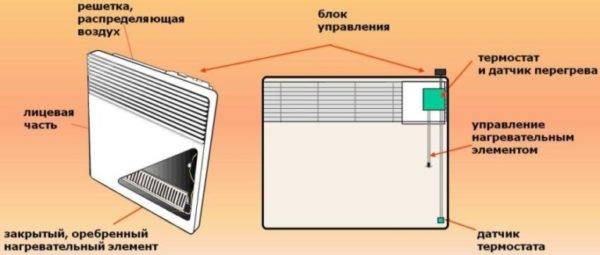

How the covector works
Advice 4. Wall-mounted electric heaters need a separate power supply line from the switchboard. It is best to buy convectors with electronic thermostats. They are more sensitive to temperature fluctuations and instantly change the power of the radiator. There are heaters that allow you to program thermostats, but they are more expensive than conventional heaters. With the help of these devices (thermostats), you can program the device for different operating modes both at night and during the day.
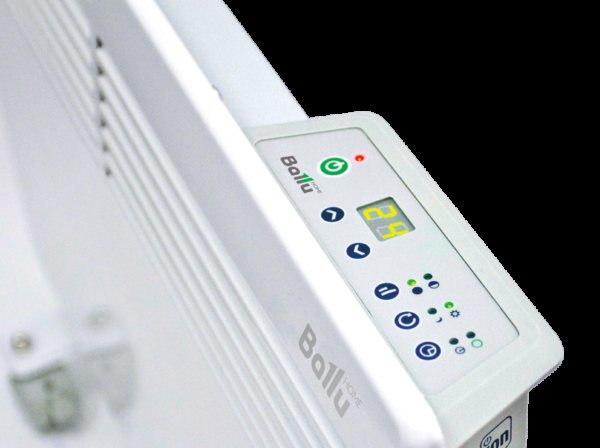

Convector with electronic thermostat
Tip 5. Choose radiators with legs, regardless of where you decide to install it: under the windowsill or on the wall. Sooner or later, it may be necessary to move the heating system to another room
Many modern batteries have a built-in rollover sensor, which is especially important if the family has children
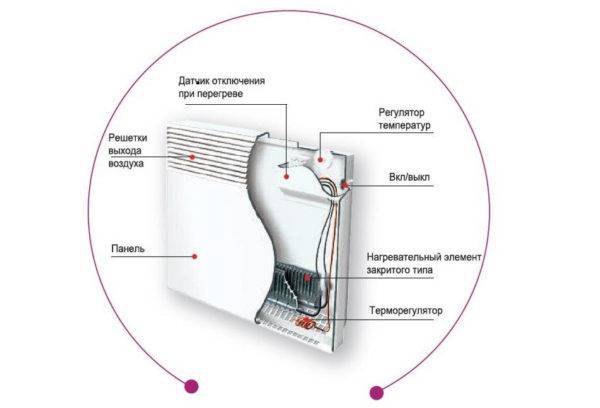

Convector structure diagram - built-in overturn sensor
Tip 6. The body is an important part of the convector. Its strength and size cannot be neglected. Quality electric heaters have a well-designed metal body for maximum heat dissipation. You should know that the thermal power of the radiator is increased by increasing the speed of air movement through the heating element. For city dwellings, it is quite possible to do with a convector with a height of 40-60 cm, and lower models are also suitable for summer cottages - up to 40 cm.Consider that all modern electric convectors, both floor-standing and wall-mounted, are equipped with a double insulating layer to protect the heating parts, therefore, they do not need additional insulation.


Various versions of the housing of electric convectors.
Tip 7. Ukrainian-made convectors are one of the most inexpensive on the market. These models are equipped with needle heaters. Despite the fact that such radiators are cheaper, the level of their electrical protection leaves much to be desired. Is it worth the risk to save money? Definitely not, even if you just come to the house for a few months. Safety is always important. Models from European manufacturers are more durable, and the heating element is a nichrome thread hidden in a steel quartz tube. The temperature of such heating systems is not too high, but European electric heaters are more durable and less capricious in use. Tip 8
Pay attention to the radiator fins. The most optimal option is 0.6-0.8 m 2 / kW
You can find the necessary data in the data sheet of the convector or on the official websites of the manufacturers, where complete information about the product is indicated. The efficiency of the device directly depends on its heating area. However, do not overpay for what you are not going to use. Too powerful a convector is more likely to lead to a waste of money and a hot indoor climate. Therefore, before buying, it is better to measure the area of the rooms where the heating will be.
Electrical wall battery device
The electric heater EffectEnergo of the Economy series consists of metal sections with high-tech shades of low power (150 or 200 W, it all depends on the model). The area of the heat-transfer surface of one part is equal to 0.4 m 2
The technical principle of the production of sections involves the installation of armored nichrome heating elements of a tubular type of low power, specifically in a mold, and the supply of an aluminum alloy under high pressure, this option makes it possible to avoid the appearance of various cavities, pores, delaminations and other disadvantages that can affect heat transfer qualities of each part. Likewise, the heating element is a tubular type, being the core and main part of each part.
EffectEnergo
Pros and cons of convectors


If you like an electric wall-mounted radiator more than others, then you should consider a convector, the principle of which is based on the laws of physics. As you know, cold air descends, and here the equipment absorbs flows into the lower grate. As they pass through the heating element, the temperature rises, the air becomes lighter and rises towards the ceiling. The convection cycle will repeat itself over and over again, and the continuous movement of air will create a comfortable indoor temperature.
Such a wall-mounted electric radiator has heating elements and a metal body. The devices are supplemented with special timers, as well as automatic controlled thermostats. The convector does not burn oxygen, does not dry out the air, is safe, easy to install and does not require human control.The only drawback may be the lack of a suitable place for installation.
Selection Tips
The selection of convectors is made for the area of the room at the rate of 80-100 W per 1 m2. If the area is 10 sq. m. a device with a power of 1 kW is required. With a ceiling height of 3 m, productivity should be increased up to 20-50%.
It is important to consider the type of thermal sensor - mechanical or automatic. Mechanical thermostats are manually set. They are 25-30% less expensive. But they provide less accurate work than electronic ones. Mechanical devices respond less accurately to changes in temperature below a predetermined mark.
We suggest that you familiarize yourself with Which heating elements are better for water heaters
https://www.youtube.com/watch?v=https:dqPPicbLcyM
Programmable devices respond more flexibly to changes in temperature conditions, provide hourly level of its maintenance. For example, during the absence of tenants, the temperature is set at 12C, and upon return - 22C.
The optimal level of moisture resistance is 21 IP. If the product is to be installed in a room with high humidity, the IP 24 device is recommended for purchase.
Oil batteries are recommended for installation in apartments, one device is enough to heat the room.
Convectors, due to their low heating temperature (60 ° C), do not burn air, they are mobile, noiseless and fireproof. The efficiency reaches up to 99%. Warm up the room quickly and are protected from overheating. Programmable products are successfully used to integrate into an electric heating system.
Fan heaters are characterized by an increased heating rate, but are noisier. Open coil devices burn oxygen. IR emitters are used to heat individual areas of the room.
Key characteristics of electronic heating convectors
According to the method of installation and fastening, electric convectors are divided into two types:
Wall-mounted models have a height of about 45 cm, and floor-standing ones have a maximum of 20 cm. Also, narrow and elongated floor-standing radiators have high efficiency due to the fact that heat exchange with the medium occurs over their entire area.
However, along with this, wall radiators have a simpler design.
The key characteristics of electric convectors are as follows:
- if the radiator has an automatic control function, it does not need to be monitored additionally;
- when the convector is in operation, the air heats up quickly and there are no drafts;
- built-in thermostat allows you to control the temperature and save energy;
- automatic control devices prevent the structure from overheating. you can also install the radiator on a surface made of any material;
- availability of special protection against moisture;
- the maximum heating temperature of the body of the structure is 65 degrees, so there is no risk of injury from contact with it;
- modern ergonomic design, no sharp corners, safe use and the ability to install even in a children's bedroom;
- when heated, the air does not acquire an unpleasant odor;
- lack of forced ventilation, so the radiator works silently.
Also on sale you can find models of wall-mounted electric radiators, which, in addition to wall mounts, are equipped with removable castors or rollers. Such a heating device can be easily installed on the wall and also easily removed from it to be installed anywhere in the room. If the electric convector has a design that is suitable only for stationary installation, then the place where it will stand must be thought out accurately and in advance so that the design does not interfere in the future and can heat the entire room.
Each model of electric heating radiator has a different average life. Basically, this term depends on how high the quality of the heating element is.For example, a heating element made in accordance with all norms and rules can work without problems for about 15 years or even longer.
At the same time, manufacturers generally indicate the warranty period of the product at least 2 years. The heating element must be in a steel case, the quality of the metal must be excellent, withstand high temperatures, much higher than the temperature of the heating element during maximum hardening.
Remember that although the electrical system of such heating devices is quite simple, it is not worth assembling them with your own hands, even if you have experience in this area. An improperly assembled and running self-made installation can lead to a fire.
What electric radiators are
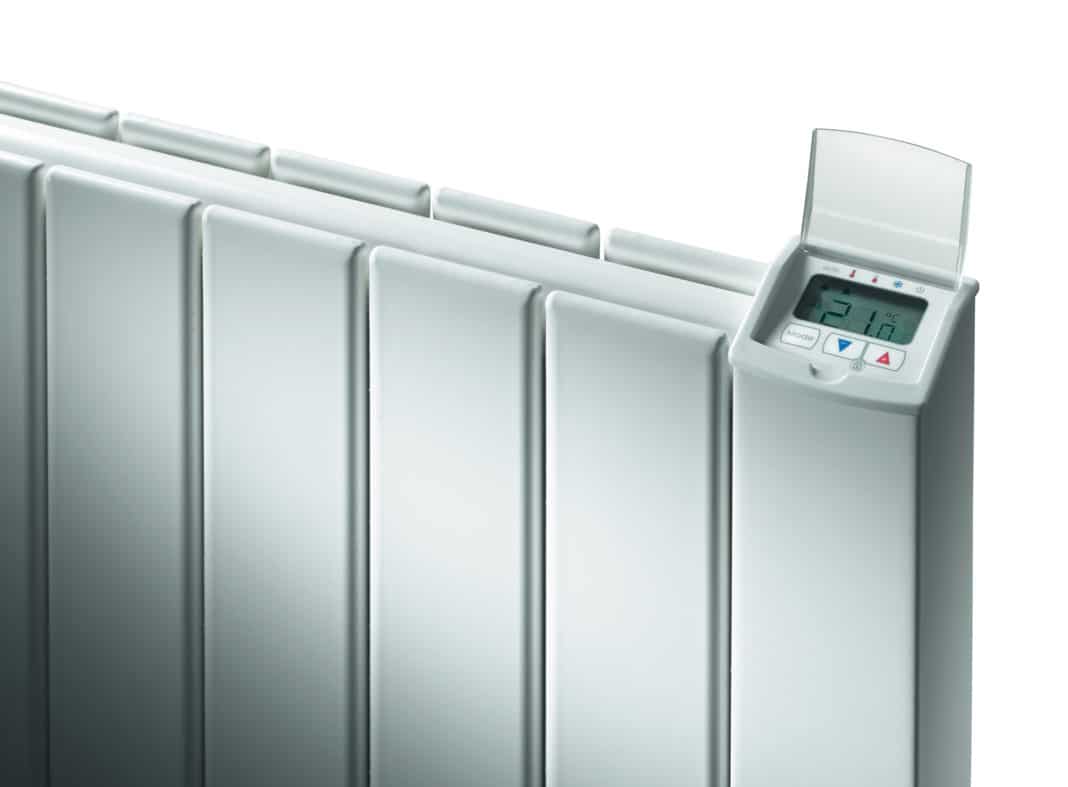

Electric radiator
The presence of a certain coolant (water, oil) between the radiator housing and the heater indicates that the heater is liquid. The absence of a coolant in the housing makes the radiator a liquid-free type.
Liquid radiator and its advantages


Liquid radiator
In a liquid radiator, heat is transferred to the metal sections from the liquid contained in the coolant with subsequent transfer into the air of the apartment (convective heat exchange). Heating of the liquid is carried out directly through the heating element. Moreover, the sections of such a radiator are structurally similar to central heating batteries. The heater is made of sections (the number of which can be selected individually, if necessary), collectors (upper and lower) with through holes. The heating element is installed in the lower collector, and the Mayevsky valve - in the upper collector.
A feature of the liquid radiator is that, if desired, it can be connected to the central heating system, and it will function in this mode. The heater can also work autonomously. In any case, pipes of the coolant (inlet and outlet) are mounted with special taps (ball). If necessary, the taps can be opened or, on the contrary, closed.
The main advantage of a liquid radiator is that this device has high efficiency and high savings rates. During the heating season, connected to the central heating, it will work from the common system. During periods when the heating season has not yet begun, or has ended (and the apartment is still not comfortable), the liquid can be heated through the heating element.
The purchase of a liquid radiator and its installation to the central heating system is sufficient for the normal heating of the apartment and the purchase of other backup heating devices is not required. This is a big plus for saving the family budget, and will also allow more efficient use of the space of the apartment (no space is required for storing heating devices in a warm period).
In this case, one important point should be taken into account. A liquid heater should be purchased with the heat carrier with which the main heating system functions. Usually used:
- distilled water, radiators with this type of liquid are used in houses that serve for permanent residence (so that there is no possibility of liquid freezing in the device)
- a liquid based on ethylene glycol (it is an anti-freeze liquid).
Liquid-free radiators and their advantages


Liquid-free radiators
Liquid-free radiators can only be used as a stand-alone heating device. Their connection to the general heat supply system is excluded. In such a device, heat transfer occurs from the heating element to the metal case (there is no coolant).
The supply of thermal energy in liquid-free radiators occurs through heat-transfer elements. They consist of several sections (as in liquid devices).
These electric radiators have the following advantages:
- high mobility, not having a coolant, have a low weight. It is possible to transfer to any part of the apartment, for heating a separate section of the area
- have a high degree of heating, thermal energy is immediately transferred to the case (the disadvantage of such a device is the insufficiently long retention of heat after shutdown)
- have increased strength (there is a possibility of the device functioning even with a punctured or broken case).
It should be noted that it is more efficient to install liquid heating devices in places of permanent residence, while dry radiators - in country houses, retail outlets (where you need to quickly heat up a room, but no one is constantly and does not live).
One of the main questions when purchasing a liquid-free radiator is how to install and fix it. There are several installation methods for any heater model:
- fixing the device to the wall using anchors. An electric heater is installed on any wall in the room that can withstand the weight of the device in working order.
- installation on a special stand
- installation on a stand with wheels (a very mobile installation method, it allows you to easily move the heater to any desired point in the apartment).
It is important to note that the presence of a set of installation elements must be checked with the seller, since some models do not have a standard, factory complete set of these important elements and there is a possibility of purchasing them additionally.
The installation of an electric heating radiator requires compliance with certain conditions for normal air circulation. To ensure the most efficient heat exchange in the room. It is recommended to install electrical appliances based on the following minimum distances:
- to the floor - 5 centimeters
- to the windowsill - 5 centimeters
- up to the wall - 3 centimeters.
Oil radiators
There are many models of heaters on the market.
Oil-fired electric heating radiators are popular among consumers and occupy the lion's share of the market. Externally, the electric oil cooler resembles a classic finned water battery. The internal structure has much in common with water radiators: mineral oil is used as a heat carrier, heated with a heating element. The heat is transferred to the finned casing and distributed throughout the room by means of thermal radiation. The number of sections (fins that increase the heat transfer area) ranges from 5 to 12 for different models, and the power of the devices ranges from 500 W to 3 kW. The dimensions of the oil coolers may vary. For ease of movement, the product is equipped with wheels.
In addition to finned ones, models in a one-piece case are available. Such devices consist of one, two or three smooth panels, heating elements in heating radiators are built into the lower part of the panels. Manufacturers offer floor-standing and wall-mounted devices. The panel wall-mounted electric oil radiator is installed in any convenient place, including under the window opening, and outwardly practically does not differ from a water heating radiator.
The electrical circuit of the oil cooler provides for automatic shutdown in case of overheating of the heating element or oil leak. There are models of devices on the market with additional features: smooth temperature control, switching heating modes, built-in ionizer, air humidifier, clothes dryer or an electronic programmer.
Oil-fired electric batteries are quiet, easy to operate and safe. The disadvantages include inertia (it takes time to warm up the oil) and a high surface temperature during heating.
We install heaters correctly
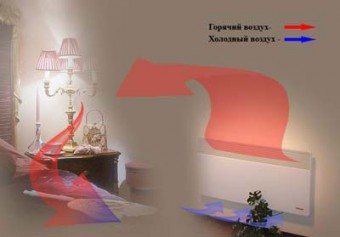

Indoor air movement with electric heater
When compared with a classic water heating system, then the circuit with electric radiators will be simpler. Let us first consider a system with direct air heating. From the point of view of reliable use, ease of installation and convenience so the system will be of interest. There is no boiler, pipes or heat carrier here. Electric heating radiators for summer cottages simply heat the air directly.
The advantage of such a system is that only a standard 220 volt electric line is needed to connect. Oil devices or convectors can be used as a heating device. Convectors are convenient wall-mounted electric heating radiators, they have thermostats and timers. Usually such a device is attached closer to the entrance or under window openings. It is worth noting that to connect such a device, the network must be grounded!
Types of electric heaters
The classification of electric heaters is mainly related to the nature of heat transfer. On this basis, there are:
- fan heaters
- convectors
- oil heaters
- infrared heaters
Fan heater
This is an electric heating device, conditionally consisting of two parts - a heater and a fan. The principle of its operation consists in pumping air by a fan through a heating chamber or a heating element. The heated air, "driven" by the fan, leaves the device at a certain speed and therefore spreads faster and more efficiently throughout the room. Heating elements can be various spirals, flat devices or heating elements - tubular heaters.
The device is equipped with a thermostat that turns it off when the set temperature is reached. In addition, it can include a fan speed controller and a timer to set the operating time. This allows you to avoid overheating during long-term operation.
Convectors
Sectional convector
In them, the transfer of heat is based on the phenomenon of convection. Convection is understood as the mixing of layers, gases or liquids with different temperatures as a result of the influence of the earth's gravity on them.
Simply put - warmer and lighter air rises up, while colder and heavier air goes down. It turns out a kind of closed circle, in the center of which there is an electric radiator. Air moves around it. As it heats up, it rises up, and when it cools down, it goes down to the radiator, and the whole cycle repeats.
These devices have automatic thermostats and timers. Water heating radiators work according to the same principle.
Oil heaters
In these devices, the working fluid is oil. Such devices do not have open heating elements, so oxygen and fine dust particles are not burned.
Moreover, the oil has a high boiling point. Therefore, unlike water, it does not boil. All this together makes the use of oil-filled electric heaters absolutely safe. All devices have standard controls and automation.
Infrared heaters
These are devices that do not heat the air, as in other cases, but the surrounding objects. This happens due to electromagnetic waves of a certain frequency. Surprisingly, the device itself remains absolutely cold.
This is still a fairly new type of heating, but its use is becoming more widespread.
Economical electric heating "EffectEnergo"
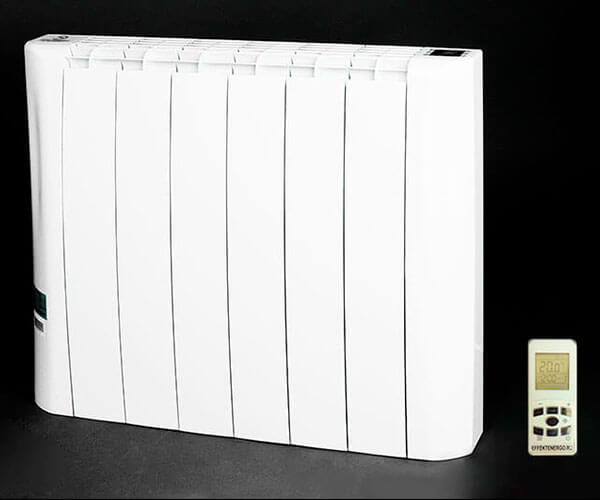

Electric radiators from today are one of the best, safe, economical and simple solutions for electric heating of a private house and summer cottage. With the help of our products, you can very quickly solve the issue of heating a room of any size and purpose, from a small country house to a huge cottage, from a small office to large production and retail space.
To install our radiators, no specialists are needed, you can easily do it yourself (15-20 minutes one radiator), no specialized sockets and reinforced wires are needed. Plug into a regular outlet, set the required temperature and enjoy a comfortable microclimate. For the optimal selection of the heating system, carefully read the description of the functional capabilities of the models of our electric radiators and use the calculator, or write to us and we will make a complete calculation of heating for your home free of charge.
Electric heating "EffectEnergo" is a complete replacement for electric boilers. Our radiators provide the same high-quality and reliable home heating as electric and gas boiler systems. At the same time, electric radiators are much more economical, easier to install, do not require piping and maintenance.
HOW THE RADIATOR IS CONSTRUCTED
EffectEnergo radiators are assembled from cast aluminum sections. Each section is a separate heating element. The technical principle of the section production involves the installation of a low-power armored heating element directly into the mold and, during the casting process, the supply of an aluminum alloy under high pressure. This method avoids the occurrence of various cavities, pores, delamination and other defects that can affect the heat transfer properties of the section. Teng, being the core and integral part of each section, evenly heats the cast aluminum, and it, in turn, "radiates" heat into the room. The design and structure of each section is designed in such a way as to efficiently convert electrical energy into heat. Simultaneously with heat radiation, heating occurs by convection, which significantly increases the efficiency and speed of warming up the room.
TOTAL NO OPERATING COSTS
Electric radiators "EffectEnergo" of the "Economy" and "Premium" series do not contain any liquids or oils inside them, therefore, the probability of leaking or defrosting of the system is completely excluded, maintenance is not required. For the full operation of the devices, only a regular 220V socket is needed. It is enough to install the radiator on a wall or on casters, plug it in and set the required temperature in the room on the display.
EFFICIENCY
Due to the large area of the heat-dissipating surface and natural convection, the room heats up quickly, and thanks to "smart" electronics, timely shutdown when the set temperature is reached. After switching off, the radiator gives off heat to the room for a long time due to the heated sections. On average, the radiator works 8-9 hours a day in consumption mode.
SECURITY
Two types of low-power nichrome heating elements with a capacity of 150 W and 200 W are used in the EffectEnergo electric radiators. The power of the heating element is selected in such a way as not to heat the section above 80 С о. Low power of heating elements, absence of open heating elements, low surface heating temperature and power interruption sensors make EffectEnergo electric radiators environmentally friendly (no dry air, burnt dust), safe (installation on any surface). Electric radiators "EffectEnergo" do not emit any radiation harmful to human health, but give people a comfortable, homely warmth.
ACCURATE TEMPERATURE CONTROL
Accurate temperature control is one of the main conditions for economical electric heating of a private house. Each "overheated" degree entails additional energy costs. All EffectEnergo electric radiators have a room temperature control sensor that will turn off the radiator when the specified temperature is reached, and turn it on again when the temperature drops by 2 ° C. Thus, you can adjust your microclimate in each room. The temperature adjustment range is from 5 C 0 to 36 C 0.
Oil for oil heater
The question of what kind of oil is in the heater does not often have to be decided, since these devices are always hermetically sealed to prevent evaporation and leakage of the working substance. During operation, replacement is extremely rare.
If there is a depressurization, then it will not be enough to add oil, first you need to repair the case and solder the leak. After restoring the tightness and in the presence of a technological hole for filling the liquid, it is possible to refuel or change the oil.
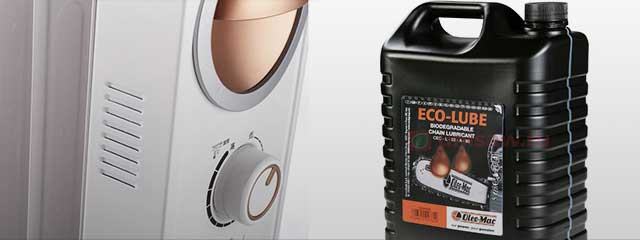

Various transformer, mineral automobile (transmission) oils and sometimes even waste oils can be poured into the oil heater.
It is important to remember that oils of different origins must not be mixed in the radiator, since
an unpleasant reaction may occur (a precipitate will form, the composition will thicken, etc.). Topping up is allowed only a substance identical in composition. It is not recommended to do this on your own. It is better to carry out repair work in specialized service centers.
Differences between bimetallic radiators
In principle, there are not so many differences - experts note that the main difference from other radiators is the presence of a double layer of metal, which can be noticed only when the batteries have not yet been fully assembled.
If we consider the properties in this context (by the way, we are talking precisely about the fact that bimetallic heating radiators, which are better than others capable of withstanding various pressure and external loads, are an ideal option), then the device can be considered universal.
Advantages and disadvantages of oil heaters
Among electric heating devices, oil ones are the only ones called electric radiators. Oil heating has a lot of advantages:
- does not dry the air;
- radiators transfer heat mainly by means of thermal radiation;
- has a safe design;
- the surface almost never heats up above 50-60 o C;
- easy installation and management.
All this is true, but there are also disadvantages. The main thing is a sufficiently large inertia. The oil, which is used to transfer heat, has a high heat capacity. And until it heats up, the air will not start to warm up. But this same property allows you to smooth out temperature differences when enabled / disabled.
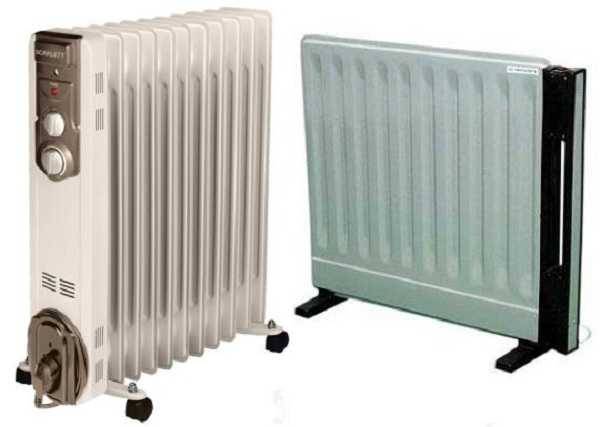

The biggest problem is high inertia and low efficiency: too many stages of heat transfer
The second disadvantage is that the safety and durability of work depends on the quality of workmanship. An incorrectly calculated design can simply burst when heated, poorly sealed seams, and oil will flow. Therefore, buying cheap, but unknown brands is a risky business.
How does an oil-fired electric heater work?
Mineral oil has a higher heat transfer than water, therefore it is used as a heat carrier in a heater.
The principle of operation of the heating device is as follows:
- Heat carrier - oil is poured into oil coolers. To increase heat transfer, only mineral technical compositions with a certain viscosity are used.
- Heating element - a heating element is used in the design, placed in a sealed case.Heating elements do not come into direct contact with oil, which ensures maximum operational safety.
- Control devices - the first models were equipped with the simplest mechanical thermostats. Modern systems used for continuous heating are equipped with several sensors to prevent overheating of the oil and housing, and an electronically controlled temperature controller. In case of an accidental fall of the heater, the power supply is automatically cut off.
- Case - manufactured in explosion-proof design. Some models have convection ducts and look like aluminum radiators.
The heating element heats the oil to a certain temperature. Good heat transfer allows you to evenly warm up the coolant. The oil is heated according to the indirect heating principle. Direct contact with the heating element is excluded.
To ensure comfortable and safe operation, all modern models use the so-called protection against "fools". Special sensors monitor the overheating of the surface of the case, accidental overturning of the device. If someone decides to dry things on the radiator (which cannot be done), the system will simply turn off the heater.
What material to choose radiator sections?
The vast majority of models are available with aluminum sections. This material has good thermal conductivity, and its sections are lightweight, affordable and attractive. When using an aluminum radiator as part of a circulation heating system, its inner surfaces are oxidized due to impurities contained in the coolant. In self-contained electric heaters, distilled water or a solution based on ethylene glycol, which does not chemically interact with aluminum, is used as a heat carrier.
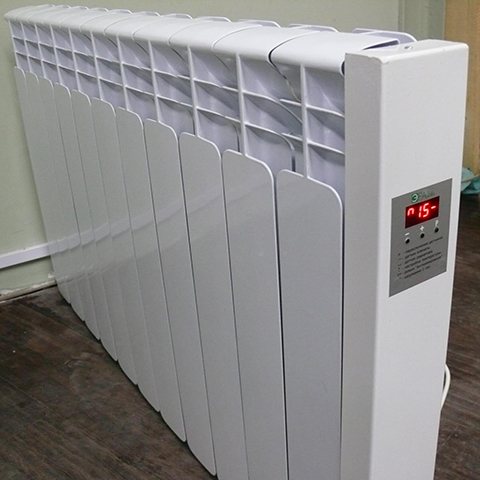

Aluminum electric radiator.
If desired, heating elements with an electronic control unit can be installed on radiators of any type - if you plan to use previously purchased heating batteries, or the use of an alternative material to aluminum is dictated by the interior design of the room. Thus, electric heating of the coolant can be implemented inside steel, bimetallic, cast iron sections, as well as design radiators made of glass or stone.
Advantages and disadvantages
Wall mounted electric economical heating radiators for summer cottages will delight you with the following positive qualities:
Dignity
- Wide range of. Specialized stores can offer you a huge variety of options to choose from, differing in the number of sections, colors and dimensions. The most powerful designs with 12 sections also have a high efficiency.
- Attractive appearance. Any wall-mounted electric radiator will perfectly fit into the design of a modern apartment, in addition, there are design models that are distinguished by special beauty and originality.
- Elementary installation instructions. The only thing you need to be able to do in this case is to drill holes in the walls, which are necessary for mounting the hooks on which the radiator itself is hung.
- High level of fire safety. The heating elements of the units in question do not come into contact with the rest of the components, which excludes the possibility of spontaneous ignition.
- Programming. One of the most striking advantages of electric radiators is the ability to fully automate the operation of the heating system. You can set the timer on and off the device, set the cycle of its operation and set a comfortable temperature for heating the air in the room.
- Minimum installation requirements.Just one socket is enough, which is simply ideal, for example, for country houses, to which it is sometimes impossible to connect a gas main, but there is electricity.
- Lack of air burning and drying effect. Arrangement of forced ventilation and use of humidifiers is not required.
- The presence of automatic protection that does not allow overheating.
- Low heating level of the case, excluding the possibility of getting burned.
Disadvantage
The only significant drawback that can be identified is the high price of electricity. But you can always set up an economical operating mode for the operation of your electric heating system, besides, there is no need for expensive piping and installation of ventilation, which also allows you to significantly reduce overall costs.
Wall mounted electric radiators are as follows:
Option number 1: oil
The principle of operation of such heaters is to use a heat transfer oil, the temperature of which rises due to the operation of a special electric heating element. From the oil, the case heats up, and from it the air surrounding the device.
It is noteworthy that the boiling point of oil is much higher than that of water, this significantly increases the possibility of heating it, and, consequently, productivity. Such units also have all the necessary set of automation.
| Designation in the diagram | Name |
| 1 | Housing |
| 2 | A pen |
| 3 | Panel |
| 4 | Thermostat |
| 5 | Switch |
| 6 | Cap |
| 7 | Coil |
| 8 | Power cable |
There are both classic horizontal and more original vertical models. It is also worth noting that water can sometimes be the basis of the coolant in heaters of this class.
Option number 2: infrared
The main feature of such an apparatus is that it heats not the air, but directly the object itself, which greatly increases the efficiency of its work. Thus, although the equipment itself is not cheap, its operation is quite economical.
| Designation in the figure | Name |
| 1 | Fastening |
| 2 | Metal case |
| 3 | A heating element |
| 4 | Ceramic hob |
(no votes yet)
Wall mounted electric heating radiators - convectors
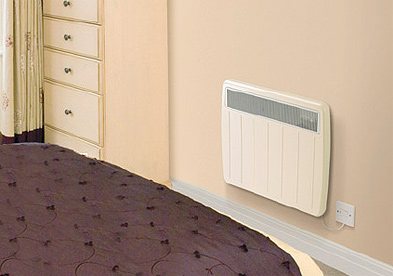

Wall mounted electric convectors can perfectly fit into any interior.
Wall mounted electric radiators are the most popular heating equipment. They are compact and economical, effectively heating the premises. The power required for heating is approximately 800 W per 10 square meters. m of living space (excluding other factors). Prices for electric wall-mounted heating batteries operating on the principle of air convection start at 1,700 rubles for a 1 kW model.
Wall convectors are installed near blank walls and under window openings. They are absolutely safe for small children, in principle it is impossible to burn yourself about them (unlike their oil counterparts), they are equipped with power control systems. If you want to get high-quality and balanced heating equipment that does not waste energy, turn your attention to wall-mounted electric radiators-convectors.

